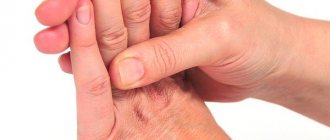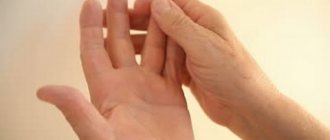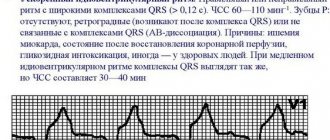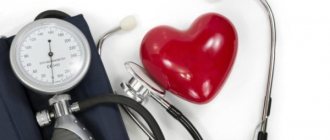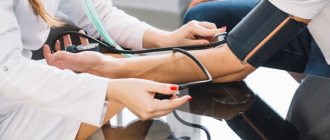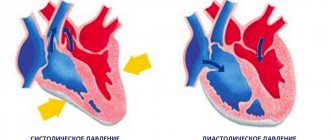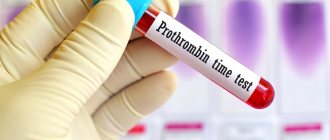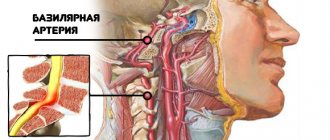Numbness is a loss of sensation in any part of the body.
Numbness may be accompanied by a tingling sensation, goosebumps, burning, tightness of the skin, as well as a feeling of cold in the numb part of the body. The most common complaints are numbness of the extremities - hands (sometimes they talk about numbness of the fingers) or legs. We perceive numbness as a loss of signal: nerve impulses from the numb area do not reach the brain. In most cases, the cause is local in nature and consists of damage to peripheral nerves or a violation of local circulation, as a result of which the nerves are deprived of the necessary nutrition. However, sometimes numbness is a symptom of a central nervous system disorder.
Physiological causes of numbness
Numbness occurs with prolonged immobility. Whatever position we are in, some vessels become pinched, and we risk that the nerve endings, which do not receive proper nutrition, will lose sensitivity. Our body must move, changing the areas that have been subjected to compression, and then we will not be in danger of numbness. This usually happens during the day. But during deep sleep, we can lie in the same position for quite a long time without changing posture. And then, when we wake up, we notice that we have rested some part of our body, for example, a hand placed under our head.
Numbness is caused by exposure to cold. When in contact with cold air, the skin loses sensitivity. Local blood circulation is disrupted, and we cease to feel the nerve endings. If this situation lasts longer, frostbite is possible, but in most cases it is enough to rub the area of skin that has lost sensitivity or return to warmth, blood circulation will be restored and the numbness will go away.
If numbness occurs without an obvious connection with a specific situation, then it probably has a pathological cause.
Cold fingers
“People with cold hands have warm hearts.” Surely you have heard and read something similar. But unlike the romantics, medicine is not so optimistic about this symptom.
General information about the symptom/condition
The symptom of cold hands most often occurs in girls and women from 15 to 45 years old, since thermoregulation in the fairer sex is usually weaker than in men. Be that as it may, this is a sign of poor circulation in the body and is caused by some disease, often more serious than low blood pressure. A person may not feel his hands even with mild hypothermia, excitement, fear and fatigue. The blood vessels on the fingers narrow, the skin first turns pale and then acquires a characteristic bluish color. Sometimes even rubbing and playing sports does not help to warm up.
Causes
Smoking is a banal and fairly common cause of cold hands. But usually this is not the case. The symptom may appear as a consequence of a lack of iron in the body and a decrease in hemoglobin levels. Rapid growth, pregnancy, breastfeeding, and blood loss (nasal and intrauterine) can contribute to this. Usually, with proper and regular nutrition, iron deficiency disappears, and with it cold hands.
Disturbances in natural metabolism may also contribute to the symptoms. This is often preceded by thyroid disease. It is not difficult to distinguish the disease - in addition to cold fingers, a person feels lethargic and lethargic. The eyelids and face often swell, the skin is dry and flaky. Since the patient has a violation of thermoregulation, he often feels cold throughout the body, in particular in the extremities.
Poor circulation can be caused by vegetative-vascular dystonia, in which a person feels tired, unwell, tingling and pain in the heart, and cold hands.
Frequent emotional stress and stress cause atherosclerosis - a disease of the circulatory system, in which blockage of blood vessels occurs and the lumen in them narrows. In the process, the blood flow in the body is disrupted and some affected areas of the body are isolated from the heat and nutrients carried by the blood. Cold hands are a common manifestation of the disease.
Coldness of the hands is most pronounced in those suffering from Raynaud's syndrome. The disease causes a characteristic blueness of the fingers, which does not go away for minutes or even hours, after which the hands turn red, heat and pain occur.
The cause of the symptom can also be hypotension, osteochondrosis and diabetes mellitus.
Numbness as a symptom
Numbness can be caused by:
- pinched nerve. A pinched nerve can occur at the point where it exits the spinal canal ( radicular syndrome
).
Therefore, numbness is a typical symptom of osteochondrosis and other spinal diseases. The nerve can also be pinched in other areas. Pinching of a nerve in its natural canal (tunnel) is defined as tunnel syndrome
.
The most common is carpal tunnel syndrome
(a pinched nerve in the wrist).
In this case, the fingers go numb. Office work (using a keyboard and mouse) contributes to the development of the disease. Also quite common is ulnar nerve neuropathy
, the development of which is facilitated by the need for prolonged support with the elbow (typical of working at a computer).
Wearing a belt, pressing the thigh against the edge of the table, or inconvenient objects in pockets can lead to pinching of the external cutaneous nerve of the thigh ( Roth disease
) - the most common foot tunnel syndrome; - injury. Trauma can disrupt the integrity of nerve fibers, resulting in loss of sensation in the area supplied by the damaged nerve;
problems of peripheral circulation. For example, the development of atherosclerosis of the vessels of the lower extremities leads to disruption of the blood supply to the legs (primarily the feet). A lack of fresh blood flow manifests itself as pale skin, a local decrease in body temperature, and numbness. Numbness may also accompany a violation of the venous outflow of blood (chronic venous insufficiency);- anemia (decreased hemoglobin in the blood). The reasons may be problems with the intake or absorption of iron, vitamins (B12, folic acid);
- polyneuropathy - multiple lesions of peripheral nerves. Polyneuropathy can be a consequence of diabetes mellitus, alcoholism, poisoning, long-term use of certain medications, autoimmune diseases, metabolic disorders and other systemic pathologies;
- diseases of the central nervous system - such as brain tumors, cerebrovascular accidents, multiple sclerosis.
Treatment with folk remedies
The following recipes help with numb hands:
- as a compress or therapeutic bath, use a mixture of 2 liters of milk, 600 g of salt and 50 g of honey, heated to 60? C;
- apply an infusion of wild rosemary with apple cider vinegar (1:3) 3 times a day;
- infusion of garlic (several cloves) in vodka (400 ml) taken orally, 3-5 drops dissolved in water;
- for 1 liter of vegetable oil - 100 g of ground black pepper, cook for 30–40 minutes, rub the cooled product into the skin of the affected limb.
In what cases should you consult a doctor if you have numbness?
If the numbness has a physiological cause, that is, caused by a temporary disruption of the local blood supply, then it is enough to change the position and rub the numb area, and sensitivity will be restored. If the numbness does not go away, then the cause is more serious and you should consult a doctor.
It is necessary to get emergency medical help if numbness is accompanied by symptoms of damage to the central nervous system:
- headache, dizziness, attacks of weakness, double vision, loss of coordination;
- unexpected bowel movements or sudden urination;
- speech problems.
These symptoms may occur after a head, neck, or back injury.
You should also consult a doctor if:
- numbness occurs periodically and without an obvious reason;
- thermal perception is impaired (for example, the ability to distinguish between warm and cold water is impaired);
- Numbness is preceded by pain and loss of range of motion in one of the joints.
Treatment and prevention of paresthesia
If you are unable to see a doctor soon, try the following self-help techniques:
- periodically warm up your arms;
- make hand baths from warm water with herbal decoctions or essential oils.
Proper nutrition and taking vitamins also help normalize hand sensitivity. However, for final recovery, diagnosis of the causes of numbness and proper treatment are required. If paresthesia is caused by a violation of local circulation, then, as a rule, massage and therapeutic exercises are recommended. For diseases of the spine, the problem is solved by taking medications (anti-inflammatory drugs, analgesics, chondroprotectors and others), physiotherapy, massage and exercise therapy. For vascular pathologies, surgical treatment is used in case of blockage of a vessel. For conservative treatment, medications (vasodilators, drugs to reduce blood viscosity and improve microcirculation) and physiotherapy can be used. No one is immune from paresthesia and inflammation of the finger, but you can reduce the risk of their occurrence by adhering to the following recommendations:
- avoid bad habits;
- exercise regularly to strengthen the spinal muscles;
- control blood pressure;
- eat right, do not get carried away with consuming fried, smoked and salty foods;
- If any kind of ailment occurs, promptly contact medical specialists.
All these measures will help you avoid problems with finger sensitivity and maintain healthy hands into old age.
Which doctor should I contact for numbness?
Numbness is a neurological symptom, so if you complain of numbness, you should consult a neurologist.
You must be prepared for the fact that a medical examination is only the first stage in solving the problem. Further instrumental studies will be required: MRI (for radicular syndrome), electroneurography, ultrasound (shows a picture of blood flow in the area under study), EEG (performed if diseases of the central nervous system are suspected). There may also be a need for laboratory tests (complete blood count, blood test for hormones, test for vitamins, etc.). Treatment for numbness is aimed, first of all, at eliminating the cause that caused it, that is, the disease whose symptom is numbness is subject to treatment. In some cases this may require considerable time.
If you are concerned about numbness in your fingers, arms or legs in general, or any other area of the body, contact the nearest clinic of JSC “Family Doctor”. Our neurologists will determine the cause of the numbness and prescribe adequate treatment. Therapeutic activities may include physiotherapy, physical therapy, massage, reflexology, manual therapy - this entire range of services is provided in the Family Doctor JSC network. Surgical treatment is carried out in the company's high-tech Hospital Center.
Treatment of pins and needles and goosebumps in the hands at the MART clinic
Goosebumps in the hands, pins and needles, numbness and other similar sensations in the hands, as a rule, indicate the presence of serious disorders in the body. Some of them can even be dangerous, and therefore you should not try to solve the existing problem yourself or using traditional methods. Prescribing the necessary treatment for goosebumps, burning sensations, pins and needles and other discomforting sensations in the right or left hand is possible only after determining the exact cause of their occurrence.
To identify the cause of paresthesia in the hands, it is necessary to undergo a thorough examination, which is recommended to begin with a visit to a neurologist. Effective treatment can only be prescribed by a doctor based on examination and additional research methods: laboratory tests, ECG, MRI, ultrasound.
At the MART medical center, treatment courses for pins and needles in the fingers and goosebumps in the hands are selected individually. If osteochondrosis or other neurological pathologies are detected, manual therapy, therapeutic massage and regular exercise therapy are prescribed. Physiotherapeutic procedures and reflexology are also used to restore normal sensitivity in the hand.
Sign up at the MART medical center in St. Petersburg (see map) by phone, or leave a request on the website.
Why does the little finger on my left hand go numb?
Paresthesia on the left requires special attention. They can be a sign of cardiovascular pathologies: angina pectoris, myocardial infarction and stroke. These conditions are accompanied by concomitant symptoms, but there are also isolated cases when only the little finger on the left hand goes numb , and then the clinical picture unfolds.
Etiological factors also include osteochondrosis, local ischemia and other pathologies listed for the corresponding finger on the opposite side.
What causes the little fingers on the hands to go numb: reasons
Bilateral, symmetrical damage is possible with:
- degenerative-dystrophic lesions of the spine;
- metabolic and autoimmune diseases: diabetes, scleroderma;
- spasm of microcirculatory vessels;
- anemia;
- alcoholic polyneuropathy;
- infections of the nervous system.
When both little fingers on the hands go numb, the reasons may be inflammatory damage to the cartilage and articular structures. These are osteoarthritis, tendovaginitis, myofascial syndromes that affect the membrane covering the muscles. This list includes rheumatoid arthritis, osteoarthritis, consequences of a fracture of the radius, and tendon sprains.
When the little and ring fingers on the hand go numb , this is a characteristic sign of radiculitis, protrusion or herniated intervertebral disc. The root cause may be cardiac ischemia, but then discomfort appears at night, and the unpleasant sensations spread to the inner side of the forearm. This symptom also occurs with hypothyroidism, a decrease in thyroid function.
The choice of therapy depends on the diagnosis. Treatment comes down to eliminating the underlying disease and local effects: applying ointments, physiotherapeutic procedures. Electrophoresis, amplipulse, laser, and magnetic therapy are recommended. Medicines used include analgesics, anti-inflammatory drugs, and muscle relaxants. Drugs that improve blood microcirculation are indicated.
